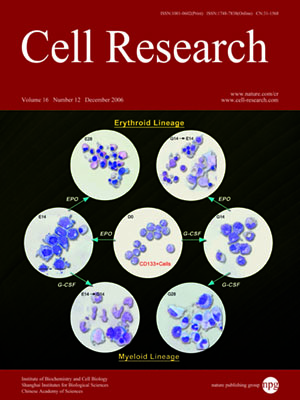
Volume 16, No 12, Dec 2006
ISSN: 1001-0602
EISSN: 1748-7838 2018
impact factor 17.848*
(Clarivate Analytics, 2019)
Volume 16 Issue 12, December 2006: 923-939
ORIGINAL ARTICLES
Identification of key genes responsible for cytokine-induced erythroid and myeloid differentiation and switching of hematopoietic stem cells by RAGE
Ling Chen, Hong Zhang, Ying Shi, Kyung L Chin, Delia C Tang, Griffin P Rodgers
1Molecular and Clinical Hematology Branch (MCHB), National Institute of Diabetes and Digestive and Kidney Diseases (NIDDK),
National Institutes of Health, Bethesda, MD 20892, USA; 2Z-BioMed, Inc., Rockville, MD 20855, USA; 3Department of Medicine,
First Affiliated Hospital, Zunyi Medical College, Zunyi 563003, China
Correspondence: Griffin P Rodgers(gprod@helix.nih.gov)
We utilized a unique culture system to analyze the expression patterns of gene, protein, and cell surface antigen, and the biological process of the related genes in erythroid and myeloid differentiation and switching of hematopoietic stem cells (HSCs) in response to cytokine alterations. Gene-specific fragments (266) identified from five populations of cytokine-stimulated HSCs were categorized into three groups: (1) expressed specifically in a single cell population; (2) expressed in two cell populations, and (3) expressed in three or more populations. Of 145 defined cDNAs, three (2%) were novel genes. Protein two-dimensional gel electrophoresis and flow cytometry analyses showed overlapped and distinguished protein expression profiles in the cell populations studied. Biological process mapping of mRNAs expressed in erythroid and myeloid lineages indicated that mRNAs shared by both lineages attended ‘core processes,’ whereas genes specifically expressed in either lineage alone were related to specific processes or cellular maturation. Data from this study support the hypothesis that committed HSCs (E14 or G14) cells can still be redirected to develop into myeloid or erythroid cells when erythropoietin (EPO) is replaced with granulocyte-colony stimulating factor (G-CSF) under erythroid-cultured condition or G-CSF with EPO in myeloid-cultured environment, respectively. Our results suggest that genes or proteins co-expressed in erythroid and myeloid lineages may be essential for the lineage maintenance and switching in hematopoiesis.
Cell Research (2006) 16:923-939. doi: 10.1038/sj.cr.7310115; published online 5 December 2006
FULL TEXT | PDF
Browse 1844


